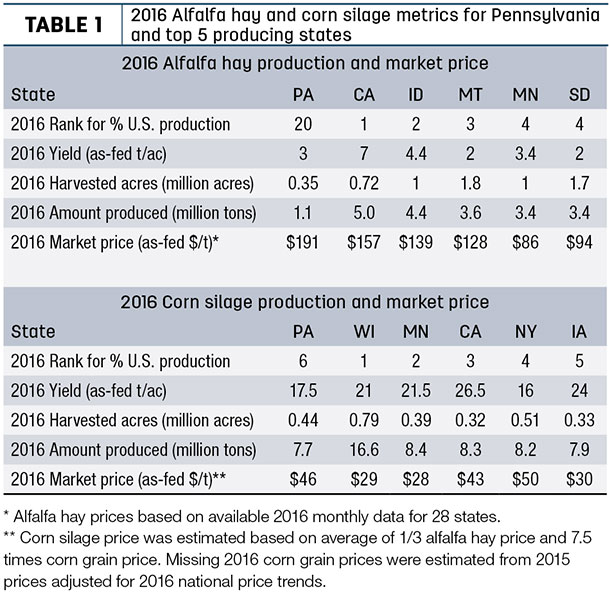During 2016, the National Agricultural Statistics Service (NASS) estimated 58 million tons of alfalfa hay and 125 million tons of corn silage were produced in the U.S. With that volume of forage being produced annually, there are a wide variety of production and price levels nationwide.
The previous article, “Raise it or buy it: Knowing the cost of production” (January 2017, Progressive Forage) examined the keys to determining home-raised feed costs and how this varies for corn silage and haylage in Pennsylvania.
One of the largest factors influencing production costs is yield. Investments into the crop such as seed, chemicals, fertilizer and operating costs associated with planting and harvesting will not change if a crop yields 12 or 24 tons per acre. Optimizing yields and quality are critical to maximizing the return on that crop investment each growing season.
This article will examine how corn silage and alfalfa hay yields varied across the U.S. in 2016 and how they compare to the five-year averages.
Production and yield
The first article examined cost of production for alfalfa as a haylage, and this article is addressing alfalfa as a hay. Not all states report the NASS alfalfa hay and haylage metric, so the alfalfa hay metric was evaluated.
Thirty-four percent of that hay production came from the top five producing states (Table 1).

Overall production is just part of the more important metric: yield per acre. This ranged from 1.1 to 8.6 tons per acre with an average of 3.5 tons per acre in 2016. For the top five states, it ranged from 2 to 7 tons per acre, with California having the highest hay output on the least number of acres and Pennsylvania’s yields just shy of the 2016 U.S. average.
Higher yields per acre for individual operations help reduce the costs of production (seed, fertilizer, general overhead, etc.), making the feed more profitable.
For corn silage, the top five states for production accounted for nearly 40 percent of the U.S. annual total (Table 1). These states also were top states for milk production. Yields for corn silage ranged from 14 to 30 tons per acre with an average of 19.9.
Most of the top five states had yields above the state average, allowing fewer acres to be dedicated to corn silage while achieving adequate production. Though state estimates for yield and production are useful, monitoring yields for individual operations allows for better decision-making for cropping management practices.
Regional differences also exist for both forages in the U.S. Table 2 depicts the five-year averages for forage yield and price across the four main regions of the U.S. Data from 2016 was excluded from this average since the completed year was not yet available at the time of this article.

The West is achieving high yields for both forages, and their market prices are also on the high side. The Midwest tended to have more average yields but had the lowest market prices for either forage.
Forage quality
Quality is important, and this is the one factor missing from this analysis. Achieving a high-yielding, quality forage is the goal of any crop production system. Various research articles discuss major factors affecting forage quality and appropriate management actions. Six major factors affecting forage quality are (in no particular order):
- Crop species
- Environment (climate/weather)
- Harvest and storage
- Maturity
- Soil fertility
- Variety
Producers can control some of these factors – but not all of them. Trying to manage the controllable factors to grow, harvest and store quality forage is important, regardless if the operation’s end goal is to sell the crop or feed it to livestock.
Market prices for haylage and corn silage
Market prices from 2016 for alfalfa hay and corn silage are also included in Table 1. Hay prices ranged from $77 to $260 per ton with an average of $147 per ton for the 28 states reporting monthly alfalfa hay prices. Market prices for most of the top five states for alfalfa production were below the U.S. average. Pennsylvania averaged $191 per ton in 2016.
In the previous article, the average cost of production in Pennsylvania planned for 2016 was $46.51 per ton for haylage, or roughly $103 per ton when converted to an as-fed hay equivalent. This demonstrates how producing home-raised feeds typically can be cheaper than buying them on the market.
Like quantity, input costs will be similar whether management is in place to achieve high-quality feed or not. It is important to calculate and monitor home-raised feed costs, both for forages intended for on-farm use with livestock or forages intended for sale at market.
There is no direct market price option for corn silage. There are several methods to estimate corn silage price from other markets, such as corn grain or alfalfa hay. Sophisticated pricing tools that account for harvest and storage costs for corn grain and corn silage, and nutrient loss from stover, can better estimate the real value of corn silage.
Corn silage pricing is very dependent on negotiating a fair price between the buyer perspective (wanting a quality forage) and seller perspective (typically interested in a grain market but willing to sell it for silage). There are several tools and articles on the web that address these conditions, including Penn State Extension Dairy Team’s spreadsheet, Price Standing Corn for Silage.
For the purpose of this article, corn silage price was an average of the silage price based on state corn grain price times 7.5 and silage price based on one-third the state alfalfa hay price. Table 1 lists these price estimations for the top five states and Pennsylvania. There is less variation in the cost of corn silage price among the top states compared to alfalfa hay.
Using Pennsylvania’s numbers, the estimated market price for corn silage was $46 per ton, and the 2016 planned cost of production reported in the previous article was $23.04 per ton. The gap between market price and estimated cost of production illustrates corn silage can be produced cheaper than if it was purchased on the market.
However, without knowing the cost of production for an individual operation, this may be a false assumption.
Yield per acre can be a pivotal part of controlling the costs of producing forage, whether it is for selling or feeding. State averages can provide some insight, but calculating and monitoring an individual operation’s costs are the best metrics to evaluating a farm’s profitability.
References omitted but are available upon request. Click here to email an editor.









